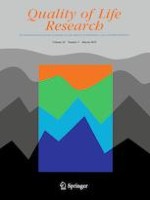20-11-2018
Psychometric properties of the Quality of Life Inventory-Disability (QI-Disability) measure
Gepubliceerd in: Quality of Life Research | Uitgave 3/2019
Log in om toegang te krijgenAbstract
Purpose
Children with intellectual disability encounter daily challenges beyond those captured in current quality of life measures. This study evaluated a new parent-report measure for children with intellectual disability, the Quality of Life Inventory-Disability (QI-Disability).
Methods
QI-Disability was administered to 253 primary caregivers of children (aged 5–18 years) with intellectual disability across four diagnostic groups: Rett syndrome, Down syndrome, cerebral palsy or autism spectrum disorder. Exploratory and confirmatory factor analyses were conducted and goodness of fit of the factor structure assessed. Associations between QI-Disability scores, and diagnostic and age groups were examined with linear regression.
Results
Six domains were identified: physical health, positive emotions, negative emotions, social interaction, leisure and the outdoors, and independence. Goodness-of-fit statistics were satisfactory and similar for the whole sample and when the sample was split by ability to walk or talk. On 100 point scales and compared to Rett syndrome, children with Down syndrome had higher leisure and the outdoors (coefficient 10.6, 95% CI 3.4,17.8) and independence (coefficient 29.7, 95% CI 22.9, 36.5) scores, whereas children with autism spectrum disorder had lower social interaction scores (coefficient − 12.8, 95% CI − 19.3, − 6.4). Scores for positive emotions (coefficient − 6.1, 95% CI − 10.7, − 1.6) and leisure and the outdoors (coefficient 5.4, 95% CI − 10.6, − 0.1) were lower for adolescents compared with children.
Conclusions
Initial evaluation suggests that QI-Disability is a reliable and valid measure of quality of life across the spectrum of intellectual disability. It has the potential to allow clearer identification of support needs and measure responsiveness to interventions.
